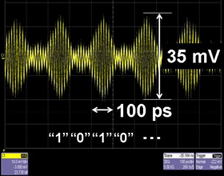Archived content
NOTE: this is an archived page and the content is likely to be out of date.
Fujitsu Develops Millimeter-Band Transmitter Capable of Data Transmission Speeds Exceeding 10 Gbps
- World's first pulse transmitter operating in 70 - 100 GHz using impulse radio -
Fujitsu Laboratories Ltd.,Fujitsu Limited
-
[1] Impulse radio
The general principles behind impulse-radio technology are the same as those commercialized by Marconi roughly a century ago in his spark-gap emitter radio. It emits a pulsed signal that varies over an extremely short period and uses a filter to extract only the portion of the band needed for transmission.
-
[2] Digital divide
Unequal access to information. Related to economic inequalities between people or regions with good access to electronic communications (especially the Internet), and those without.
-
[3] Radio window
Typically with radio, as frequencies increase so does atmospheric absorption, thereby attenuating the signal so that it can carry less. But absorption decreases in the region around certain frequencies (40 GHz, 90 GHz, 220 GHz, etc), permitting carriage over relatively long distances. These bands behave somewhat like a "window" through the air, hence the origin for this name.
-
[4] Short pulse
A pulse is a signal that rises and falls, describing a fixed shape over a fixed period of time. A short pulse is one where the signal varies over a short period of time.
-
[5] Full-width at half-maximum (FWHM)
Taking the full extent of a pulse's variation as 1, this is the amount of time the pulse spends above one-half (1/2) value. A pulse with a low FWHM carries high-frequency energy.
-
[6] Indium phosphide high electron-mobility transistor (InP-HEMT)
Invented in 1979 by Fujitsu Laboratories' Takashi Mimura (currently a Fellow at Fujitsu Laboratories), this is a transistor made of compound semiconductors with excellent speed and noise characteristics. Using an indium-phosphide (InP) substrate results in higher speed and lower noise than with conventional gallium-arsenide. This is considered useful in high-speed communications and millimeter-band image sensors.
-
[7] Skin effect
A phenomenon observed when high-frequency current is flowing through a conductor, where the higher the frequency, the more current tends to concentrate near the surface of the conductor. In effect, resistance increases the higher the frequency.
About Fujitsu Laboratories
Founded in 1968 as a wholly owned subsidiary of Fujitsu Limited, Fujitsu Laboratories Limited is one of the premier research centers in the world. With a global network of laboratories in Japan, China, the United States and Europe, the organization conducts a wide range of basic and applied research in the areas of Multimedia, Personal Systems, Networks, Peripherals, Advanced Materials and Electronic Devices. For more information, please see:http://jp.fujitsu.com/group/labs/en/
About Fujitsu
Fujitsu is a leading provider of IT-based business solutions for the global marketplace. With approximately 160,000 employees supporting customers in 70 countries, Fujitsu combines a worldwide corps of systems and services experts with highly reliable computing and communications products and advanced microelectronics to deliver added value to customers. Headquartered in Tokyo, Fujitsu Limited (TSE:6702) reported consolidated revenues of 5.3 trillion yen (US$53 billion) for the fiscal year ended March 31, 2008. For more information, please see: www.fujitsu.com.
Technical Contacts
Advanced Devices Research Lab.Platform Technologies Research Center
![]() Phone: +81(46)250-8244
Phone: +81(46)250-8244
![]() E-mail: kikan-press@ml.labs.fujitsu.com
E-mail: kikan-press@ml.labs.fujitsu.com
Company:Fujitsu Laboratories Limited
Company and product names referenced herein are trademarks or registered trademarks of their respective owners. Information provided in this press release is accurate at time of publication and is subject to change without advance notice.
Date: 19 June, 2008
City: Kawasaki and Tokyo, Japan
Company:
Fujitsu Laboratories Ltd.,
Fujitsu Limited,
,
,
,


